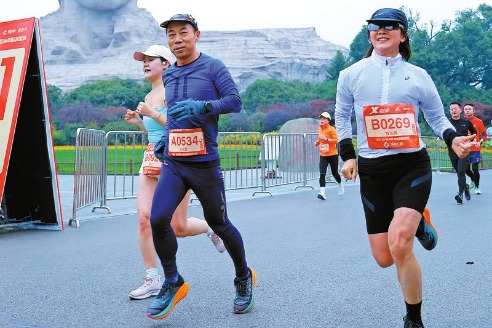Fudan team develops new kind of chips
Breakthrough likely to end reliance on traditional silicon-based ones

Researchers in Shanghai have developed the world's largest integrated two-dimensional semiconductor microprocessor, a breakthrough that could revolutionize the industry by replacing traditional silicon-based chips with molybdenum disulfide, or MoS2.
The micro CPU, called WUJI, integrates a record-breaking 5,900 transistors, far surpassing the previous world record of 115. The more transistors a chip contains, the greater its data processing capability, scientists said.
The research was led by Zhou Peng and Bao Wenzhong of Fudan University's State Key Laboratory of Integrated Chips and Systems, and the findings were published in the journal Nature on Thursday.
The development comes as Moore's Law — the principle that the number of transistors on a microchip doubles about every two years — is approaching its physical limits. Two-dimensional semiconductors, with atomic-scale thickness, are seen internationally as a key solution to sustaining progress in microprocessor technology.
After more than a decade of efforts by researchers worldwide, scientists have mastered wafer-level 2D material growth and successfully manufactured high-performance components with features only a few hundred atoms long and a few atomic layers thick.
However, building complete integrated circuits with such atomic-level precision has long been hindered by challenges in maintaining accuracy and uniformity at scale. Until now, the highest integration level had remained in the hundreds of transistors, without crossing the technical threshold of functional processors.
After five years of research and development, the Fudan University team created WUJI using the 32-bit RISC-V architecture and MoS2. By employing innovative processing techniques and the open-source RISC-V instruction set, WUJI set a global record for 2D logic function verification, integrating 5,900 transistors.
The researchers completed the entire chain of independent research and development, from materials to architecture and chip design.
"Controlled by 32-bit input instructions, WUJI can perform addition and subtraction operations on numbers up to 4.2 billion, support gigabyte-level data storage and access, and execute up to a billion simplified instruction set commands," Zhou said.
The Fudan team has spent more than a decade researching 2D semiconductor integrated circuits. Their AI-driven optimization technology, which combines atomic-level precision control with full-process AI algorithm optimization, allowed for precise control from material growth to integrated processing, researchers said.
The complex technological process of WUJI made it difficult to manually set parameters, but by integrating machine learning, the research team quickly optimized key parameters and improved transistor yield, Zhou said.
About 70 percent of the processes used in WUJI's 2D semiconductor integration can directly adopt mature technologies from existing silicon-based production lines, while the core 2D processes are protected by more than 20 process invention patents.
The researchers have also developed a specialized technical system, paving the way for future industrialization.
In their study, the inverter yield — the percentage of produced chips that function correctly — reached 99.77 percent, and both integrated process optimization and large-scale circuit verification achieved the highest international standards.
"We have achieved nanometer-level power consumption using micrometer-level processes. A low-power CPU can help drive broader applications of artificial intelligence," Zhou said.
AI requires significant power for reasoning and training, and energy consumption is a major limitation on computing power expansion, he said.
"By using new computing architectures that enable low-power operation, we can potentially boost AI capabilities," Zhou said.





































